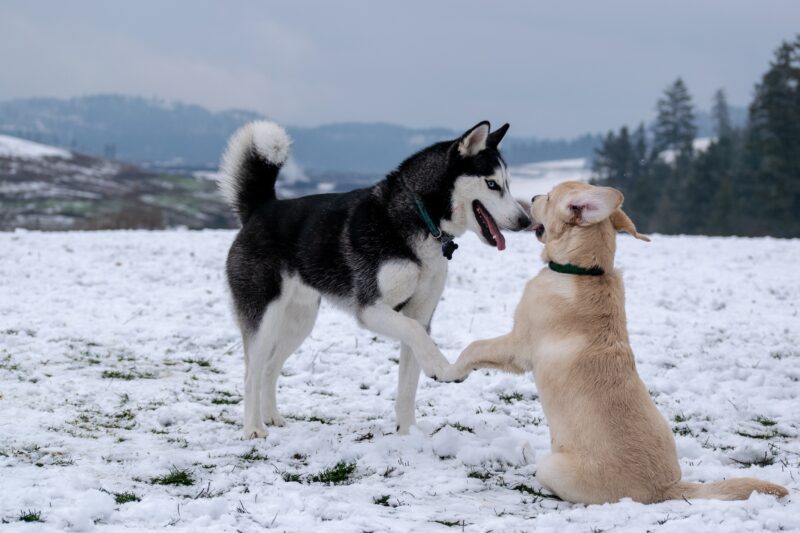Is there a secret dog language our furry friends use to talk to each other? Are there different types of bark or is it all just noise? What’s with all the butt sniffing?
Let’s answer these questions and more as we learn about dog communication!
Do Dogs Talk To Each Other By Barking?
While they don’t have a language anywhere near as developed as us humans, dogs are definitely communicating something to each other when they bark, and it could be described as a basic conversation between the two.
Think of it as if someone is talking to you in another language. The words themselves will not have any literal meaning for you, but you can get a basic idea of what they are trying to communicate. Put together with body language, you will know if they are happy, sad, angry, worried, etc.
The message being conveyed in a bark depends on:
- The number of barks: the more barks there are in a row, more emotionally excited or worked up the dog is.
- The pitch: a lower pitch is normally a warning, while a higher tone is often a happy bark. A high pitched bark can sometimes be a call for companionship too, especially when rising in tone to almost a yelp.
- The speed: the less there is space between barks, the more aggressive he is probably feeling.
Combined with howls, growls , whines, whimpers and sighs the range of communication dogs have with each other just vocally is quite high.
Do Dogs Talk To Each Other Without Barking?
Barking is far from the only way dogs talk to each other.
In fact, barking will normally only be used to relay something perceived as urgent, exciting, or to broadcast a message to someone further away. A little like how we might shout a warning, raise our voice a little if we really like (or dislike) something, or cry for help.
Puppies tend to bark a lot as, for them, most things are urgent and exciting!
So how do dogs communicate if not through barking?
Most of a dog’s ‘talking’ will be done with of:
- Body language
- Facial Expressions
- The tail
- Touch
- Smell
Let’s have a look at each of these before we touch on one of the most important areas of dog communication: calming signals.
Body Language
Dogs primarily use non-verbal communication, and body language is a big part of it. Posture and movement both play a part.
Posture
If a dog is standing tall with a stiff posture, he’s on alert and ready for action, while if he’s making himself small and being cautious, with his weight on his back legs, he’s saying he’s worried about something that he’s not sure he can deal with.
Head Position
A raised head shows interest and confidence. A head hung low is submissive.
Hackles
When a dog is scared, threatened, or even just very interested in something, his hackles may go up. These are the hairs running along his neck and back. The fur will stand up mainly around the shoulder area, but sometimes right down to the tail. This is similar to how us humans get goosebumps and is also know as piloerection.
Play Bow
An obvious example is the ‘play bow’, where his rear remains high while the front legs and head are lowered to the ground, with an open mouth and wagging tail. This is an invitation to play a game, and anything that happens afterwards is not to be taken seriously.
It can also be used as an apology, sort of like saying “sorry about that, let’s play a game!”
Raising On Hind legs
This is another ‘lets play’ action. When a dog raises on his hind legs he’s found someone he thinks might engage in a game!
Raised Paw
When a dog raises his paw he is saying he’s uncertain about the situation, and perhaps a little nervous. An exception to this is with pointing breeds, who use their paw to point in the direction they smell prey.
Facial Expressions
Just like with people, a dog’s face can tell you a lot about how he’s feeling.
Mouth
An open mouth with the teeth apart, and often the tongue hanging out, is a sign of a relaxed dog. He may also have the corners of his mouth turned up like a smile.
Curled back lips exposing clenched teeth is a sign of aggression, or a warning that he will defend himself if pushed. The muzzle and forehead will be tense, and he may well growl at the same time.
Anxious dogs may yawn or lick their lips.
Ears
Just like with the tail, the position of a dog’s ears indicate how he’s feeling.
- Fully alert: all the way forward and pointing up
- Scared or submissive: pinned back against his head
This can be difficult to spot with some breeds, for example those with big floppy ears, but can still be seen by looking at the base of the ear.
Eyes
They say the eyes don’t lie, and this is certainly true for dogs. They are a very reliable indicator for how he’s feeling.
- Soft Eyes: a relaxed dog will have relaxed eyelids that are partially closed, making them an almond shape, like he’s squinting.
- Hard Eyes: an alert dog will have them open with dilated pupils. This indicates that something has his attention, and he may be feeling threatened or frightened.
- Staring: direct eye contact is not polite in dog communication, and staring for a long time can be a warning or a sign of aggression if combined with other indicators such as an upright, stiff posture, raised hackles and ears pointing forward.
- Whale Eye: when a dog is uncomfortable with someone he may well avert his gaze and look away from them. This will be usually be accompanied with other submissive gestures, such as having his head low, and the whites of his eyes will be visible. He’s basically saying “I don’t want any trouble”.
The Tail
The tail is a good indicator of how confident a dog is feeling:
- Up as high as it can be: he is feeling very confident.
- Curled between his legs: he is fearful or submissive.
- Neutral position: relaxed.
The neutral position is somewhere around the halfway mark, . This is dependant on breed and the individual dog, so get to know your dog’s neutral tail position so you can quickly gauge how he is feeling compared to normal.
Wagging
A dog with a wagging tail is often thought to be happy. While this is certainly a reason for tail-wagging, it is not always the case. The faster the tail is wagging indicates how emotionally aroused or excited a dog is, which could be good or bad.
Here’s what to look for:
- Tail swinging leisurely from side to side: almost certainly relaxed and happy.
- Spinning rapidly in a circle: excited, but again likely to be happy.
- Moving rapidly and loosely from side to side: excited and probably happy.
- Moving rapidly and stiffly from side to side: he’s alert and on edge, and may feel threatened. He may become aggressive if whatever has his attention doesn’t back off.
The side it is mostly wagging on can be a sign too. A 2007 study on tail-wagging indicates that a dog is more likely to be happy if his tail favors his right side when wagging, and unhappy if it’s more to his left side (as viewed from behind).
Touch
Dogs use touch mostly with those they are, or would like to be, friends with.
Paw Slap
A sure sign he’s found a friend. This is like slapping someone on the shoulder and saying “hey, you’re alright!”
Resting
A dog resting his head on another dog (or person!) is a way of showing affection and trust. Between dogs, it may also be a sign that the dog doing the resting is more dominant at that time.
Nipping
Often a part of play fights, as long as a dog is well socialised it’s normally harmless and friendly. They are careful not to bite too hard and will avoid sensitive areas. Puppies tend to do this more than adult dogs.
Smell
Dogs also use their amazing sense of smell to get information about other dogs.
Urination
Along with marking territory, dogs urinate on things as a way of leaving messages for others. By sniffing where another dog has urinated, they can find out a lot about who was there before: such as their gender, health, mood, where they’ve been and what they’ve been eating.
Scent
When two dogs meet they can get this same report from each others’ scent, or more detailed information by sniffing in a more personal area.
Noses
They will also often sniff each other’s noses. Because their noses are wet, particles from whatever they’ve been sniffing or eating get trapped there. When another dog sniffs their nose, they can find out what’s good to eat nearby and other local information!
Calming Signals
Used by dogs the world over, calming signals are both a way to self-soothe and to ask someone to calm down.
This is a legacy behavior from their pack animal roots, where conflicts within the group could threaten their survival.
There are several calming signals, but some of the more common ones are:
- Yawning
- Lip/nose licking
- Looking away
- Turning to face the other direction
- Sniffing the ground
- Moving slowly or freezing
If you see one of these behaviors, it is possible the dog is starting to feel a little stressed and is trying to calm the situation down. Of course, there are plenty of other reasons why they might do any of these things, so do consider the context.
Final Thoughts
Dogs do indeed talk to each other, and the language is actually quite complex with many different signs and signals coming into play.
If you have a dog, or you’re around them often, it’s definitely worth paying attention and trying to learn a bit of dog language. After all, they’re nice enough to learn some of our words when we teach them so it’s only polite.
Pay attention to the tail, ears, posture, facial expressions and movement, and be sure to look out for calming signals.
Communication is key to any relationship: if you can learn to understand what your dog is trying to tell you, the bond between you will strengthen immensely.
Dog Communication FAQs
Do dogs try to talk to humans?
Absolutely. They give us the same signals they give to other dogs, and if we don't pick up on them it often leads to misunderstandings between us. For example, you shout for your dog to come to you but he just sits there, yawns, and looks away from you. You think he's ignoring you, but he's trying to tell you that you're making him uneasy and he would like you to calm down a little. It's on us to learn to listen to what they're saying.
Can dogs talk to cats?
There's no definitive answer, but as both their verbal and non-verbal communication is quite different, probably not. However, if they live together, they will likely understand each other better over time. As a simple example, if the dog barks at the cat before chasing it, the cat will learn pretty quickly what being barked at means!
Can dogs have conversations with each other?
Yes they can! It's not a conversation as we know it, and very little of it involves barking. An example of a dog conversation might go like this:
Rover is playing with his toy when Fido approaches. Rover stands up tall, stiffens his posture and shows his teeth, meaning "don't come any closer, this is my toy and you can't have it!".
Fido stops where he is, lowers his head, looks away, and yawns, meaning "I'm not a threat, calm down".
Rover acknowledges by licking his nose.
Can all dogs understand each other?
Generally, yes they can. While not every signal a dog sends out may be understood by another, they are constantly sending enough of them through their body language etc. that the message will almost certainly get through.
References
- Asymmetric tail-wagging responses by dogs to different emotive stimuli – A. Quaranta, M. Siniscalchi, G. Vallortigara
- On Talking Terms With Dogs: Calming Signals – Turid Rugaas
Feature image by Karl Anderson







